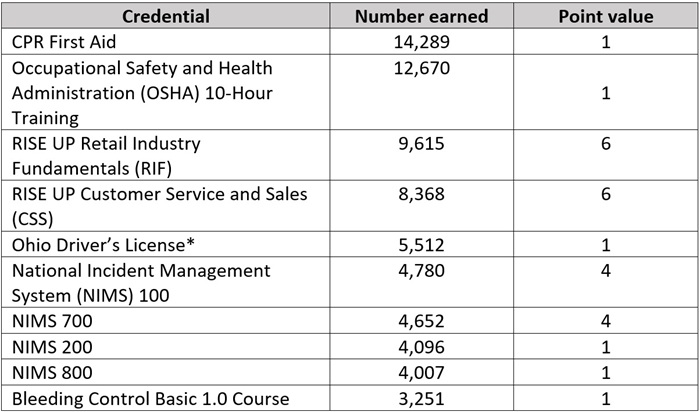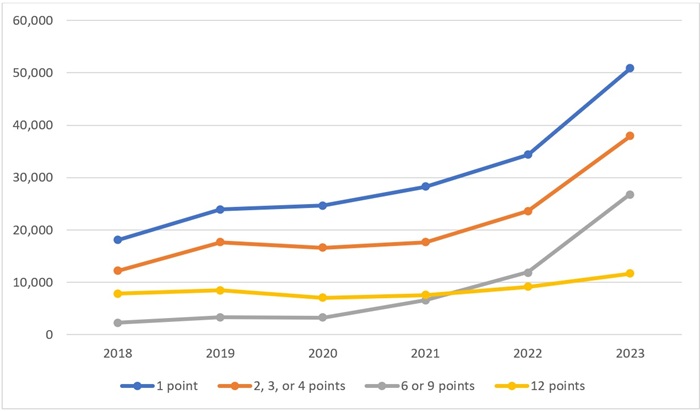Under the leadership of Governor DeWine, Ohio has invested significant time, effort, and funding into expanding and improving career pathways. Well-designed pathways often include the opportunity to earn industry-recognized credentials (IRCs), which allow students to demonstrate their knowledge and skills and verify their competence via an objective, third-party measure. IRCs signal to employers that students are well-prepared. They can boost earnings and employment. And in Ohio, high school students can use IRCs as a pathway to graduation.
To determine which IRCs qualify for graduation, Ohio policymakers have established a framework that includes a review and approval process, as well as a point value system. A committee that consists of representatives from the Department of Education and Workforce (DEW), the Governor’s Office of Workforce Transformation, and professional business organizations reviews IRCs that are submitted for consideration. The current review process includes an Ohio labor market audit, an assessment of the credential’s alignment to career field technical content standards, and an analysis of industry feedback. IRCs that make the cut are assigned a point value between one and twelve. For example, within the health career field, credentials like CPR First Aid or respiratory protection are each worth one point. In that same career field, a Certified Pharmacy Technician is worth twelve points. Students can meet graduation requirements by earning a credential or group of credentials that add to at least twelve points.
DeWine’s proposed budget would overhaul this process. The bill eliminates requirements for the committee to assign a point value to each IRC and to establish the total number of points that can be used to qualify for a diploma. Instead, the committee would be required to “establish the criteria under which a student may use industry-recognized credentials to help qualify for a high school diploma.” In other words, the governor has proposed going back to the drawing board on IRCs and their applicability to graduation.
Why do this? Ohio’s current point value system doesn’t effectively identify credential value or encourage students to earn IRCs that will lead to better long-term outcomes. That’s a big problem. And due to flaws in the current system, students are accumulating IRCs that are poorly aligned with in-demand, high-value careers—credentials that won’t get them very far professionally.
Consider Table 1 below, which shows that none of the top ten credentials earned by the class of 2023 are worth twelve points. Half are worth just one point.
Table 1. Top ten credentials earned statewide by the class of 2023

The prevalence of one-point credentials isn’t a recent development, either. Chart 2 demonstrates that credentials worth one point have consistently been the most earned since 2018. Over the last six years, the number of twelve-point IRCs being earned hasn’t increased as rapidly as the number of one-point IRCs earned. And the gap between the two has grown each year. In 2018, the gap between one-point and twelve-point credentials was just over 10,000. By 2023, it had grown to more than 39,000.
Chart 1. Credentials earned statewide according to point value, 2018–2023

Part of the reason why so many students are earning low point credentials is because they can be bundled to graduate. In fact, there’s data suggesting that Ohio’s urban districts are routing students into less rigorous IRC programs to ensure they receive diplomas. Earlier this year, my colleague Aaron Churchill analyzed the ten most commonly earned IRCs by the class of 2023 in urban districts. He found that, although hundreds of IRCs appear on the state’s approved list, attainment numbers in these districts were dominated by only a few credentials. Many of them—retail-based certificates, emergency management certificates, and one-point credentials like CPR First Aid and OSHA 10-hour job safety—don’t take much time or effort to earn and lead to industries and jobs that pay relatively low wages.
Fortunately, DeWine’s proposed budget could solve these problems—but only if the new criteria that replace the point value system are better. To ensure this happens, Ohio needs to establish a data-driven framework that identifies the impact of specific credentials on workforce outcomes and incentivizes students and schools to focus on IRCs that are truly valuable. With that in mind, lawmakers should consider adding the following provisions to the budget bill.
1. Require the committee to link credentials to wages.
If a credential doesn’t ensure that a student is financially better off for having earned it, then it shouldn’t be considered valuable by the state and shouldn’t be a pathway to graduation. Ohio’s Department of Job and Family Services already offers data search tools that outline wages by occupation and industry. It’s time to include credentials in that data, too. Students deserve to know the wages they can expect before they invest time and effort to earn a credential. School counselors and educators need access to that information so they can provide meaningful career advising. And state leaders need to ensure that state policy focuses incentives on credentials that lead to better earnings for students.
2. Require the committee to link credentials to job outlook.
The committee that oversees Ohio’s current system considers labor market data and industry feedback when deciding which credentials to approve and their point values. But the process is far from transparent. It also doesn’t give students, families, or educators access to data showing projected job growth over time and across geographic regions. Without these data, students can’t make informed decisions. Lawmakers should call on the committee to incorporate two job outlook measures in the new criteria—one that focuses on short-term demand according to feedback from industry partners, and a second that considers long-term job outlook based on projected data.
3. Require the committee to establish a three-tiered system.
The new data-driven framework should be used to assign IRCs to one of three tiers: Preferred, Valued, or Recognized. Students should be permitted to earn an IRC in any of these tiers. But only credentials that are either Valued or Preferred—those that are considered beneficial by employers, lead to well-paying jobs, and have a positive future outlook—should count toward meeting graduation requirements.
***
Over the last few years, Ohio policymakers have prioritized improving career pathways. Expanding opportunities to earn an IRC has been a key part of those efforts. The good news is that these efforts are working, and more students are earning credentials than ever before. The bad news is that Ohio’s current system doesn’t effectively identify credential value or encourage students to earn credentials that will lead to better outcomes. With his budget, Governor DeWine took an important first step toward fixing this system. But lawmakers can and should do more—including explicitly linking credentials to wages and job outlook, and establishing a tiered system that feeds into graduation requirements.




